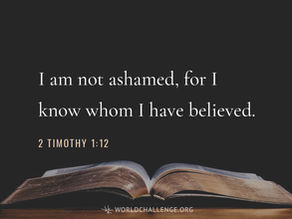1 John 4:7-10 - Loopy Love
- Chad Werkhoven
- May 22, 2024
- 3 min read
John's poetic style defines God's love and grace.
1 John 4:7-10 (NIV)
7 Dear friends, let us love one another, for love comes from God. Everyone who loves has been born of God and knows God. 8 Whoever does not love does not know God, because God is love. 9 This is how God showed his love among us: He sent his one and only Son into the world that we might live through him. 10 This is love: not that we loved God, but that he loved us and sent his Son as an atoning sacrifice for our sins.
Listen to passage & devotional:
Belgic Confession of Faith, Article 17: The Recovery of Fallen Man
We believe that our good God,
by his marvelous wisdom and goodness,
seeing that man had plunged himself in this manner
into both physical and spiritual death
and made himself completely miserable,
set out to find him,
though man,
trembling all over,
was fleeing from him.
And he comforted him,
promising to give him his Son,
“born of a woman,”
to crush the head of the serpent,
and to make him blessed.
Summary
It often seems like John writes in big loops, like he's repeating the same thing over and over in slightly different ways. This is by design. In our western style, we tend to organize our thoughts like Paul, using an outline format like what you learned in school:
Point 1
Subpoint
Subpoint
Point 2
Subpoint
Subpoint
John, on the other hand, writes in a more near-eastern style, using a chaisitic format. Here's how the passage we just read is organized:
We must love one another. Here's why:
A: Definition of love: it comes from God
B: People show love: indicate they're born of God
C: If you don't love you don't know God
C': because God is love
B':God shows love: by sending His Son that we might live through Him
A': Definition of love: Not what we do, but what God has done.
Chiasms are recognized by the wedge shape of the outline. The upper portion looks similar to the outlining style we're more familiar with, in the typical A, B, C pattern. But then the lower portion reverses the order: C, B, A. Each of the letters in the upper portion correspond to the same letter in the lower portion.
One of the biggest difference in this chiastic style is that the primary meaning of the passage doesn't come at the end, where we would normally expect it, but right smack in the middle. In the case of this passage, the primary message that John wishes to convey is that God is love, and that if you know God, you will love too.
Dig Deeper
Ironically, it's the final line in John's passage that attracts our attention today. Although it's not the primary point in this passage, it still is certainly true!
This is love: not that we loved God, but that he loved us and sent his Son as an atoning sacrifice for our sins.
But even this single verse is organized chiastically!
A: Definition of love: This is love
B: How we showed love: not that we loved God,
C: Who God is: but that he loved us
B': How God showed love: and sent his Son as
A': Definition of love: an atoning sacrifice for our sins.
This means that the key to our salvation is certainly not rooted in our ability to turn to God on our own, but is fully based on God's character and attributes: God is love, and he demonstrates this love by sending His Son, and He defines love by giving us the atoning sacrifice we need to have peace with Him.
So according to John, who's chiastic writing style can sometimes confuse our western sensibilities, the key takeaway from these doctrines of grace we've been studying these last few weeks is that you must demonstrate the very same love of the God whose image you've been created in by loving others in a way that defines what it means to be at peace with Him.
ACKNOWLEDGE WHO GOD IS: Our Father, God, who is love;
ALIGN YOUR LIFE WITH GOD'S WILL: Ask God for the ability to love others as He has first loved you;
ASK GOD FOR WHAT YOU NEED:
Read the New Testament in a year! Today: Romans 7




















Comments